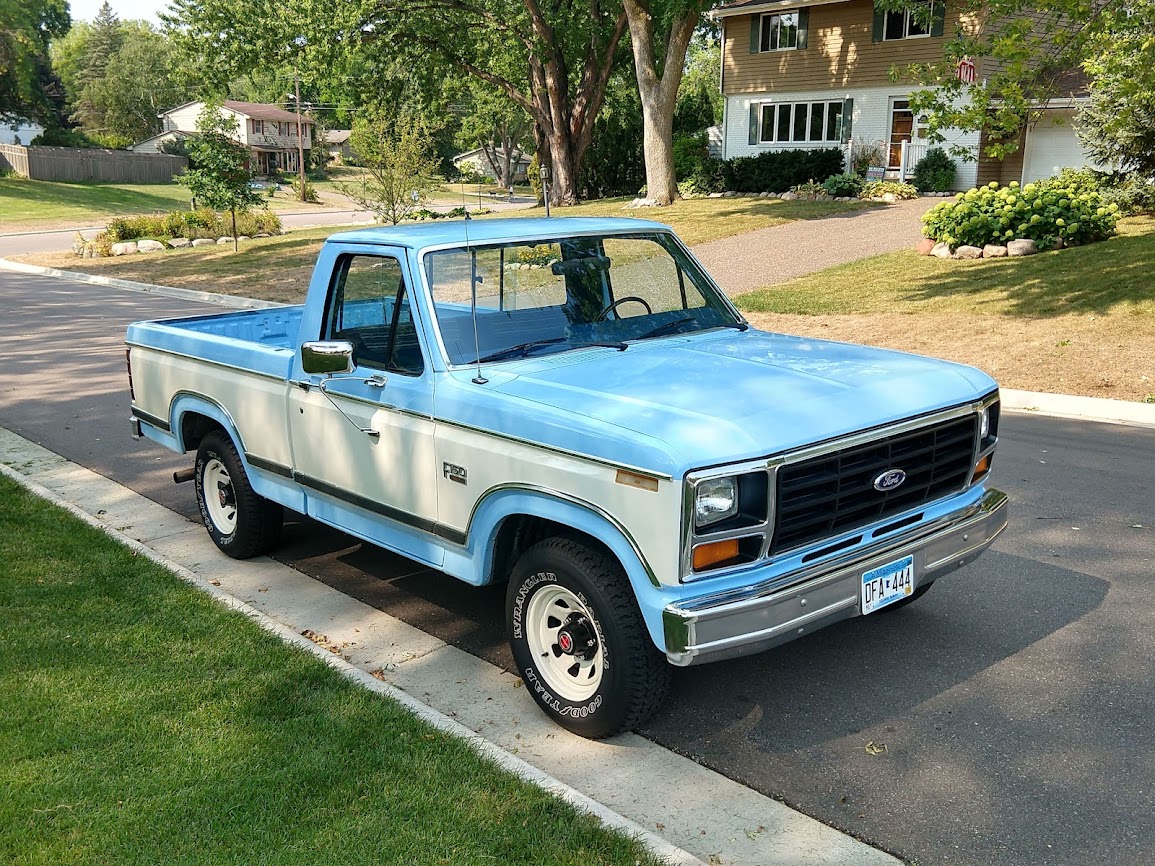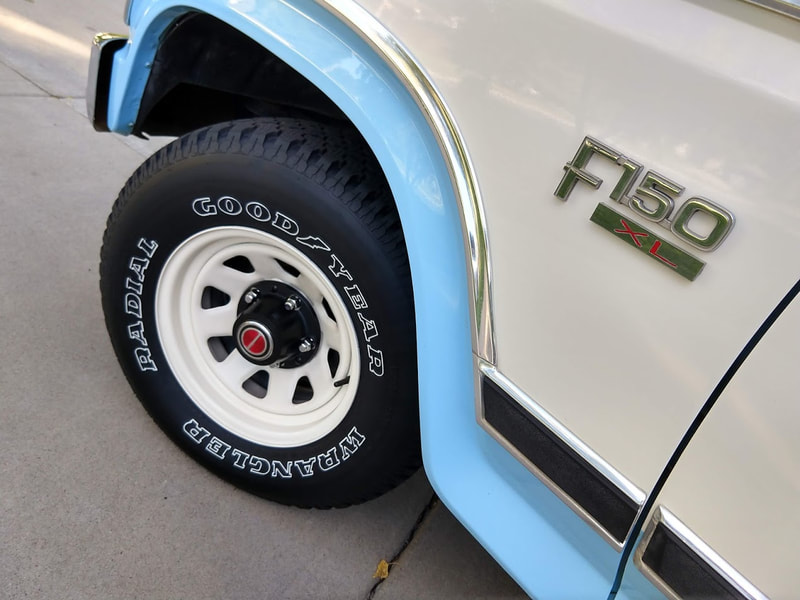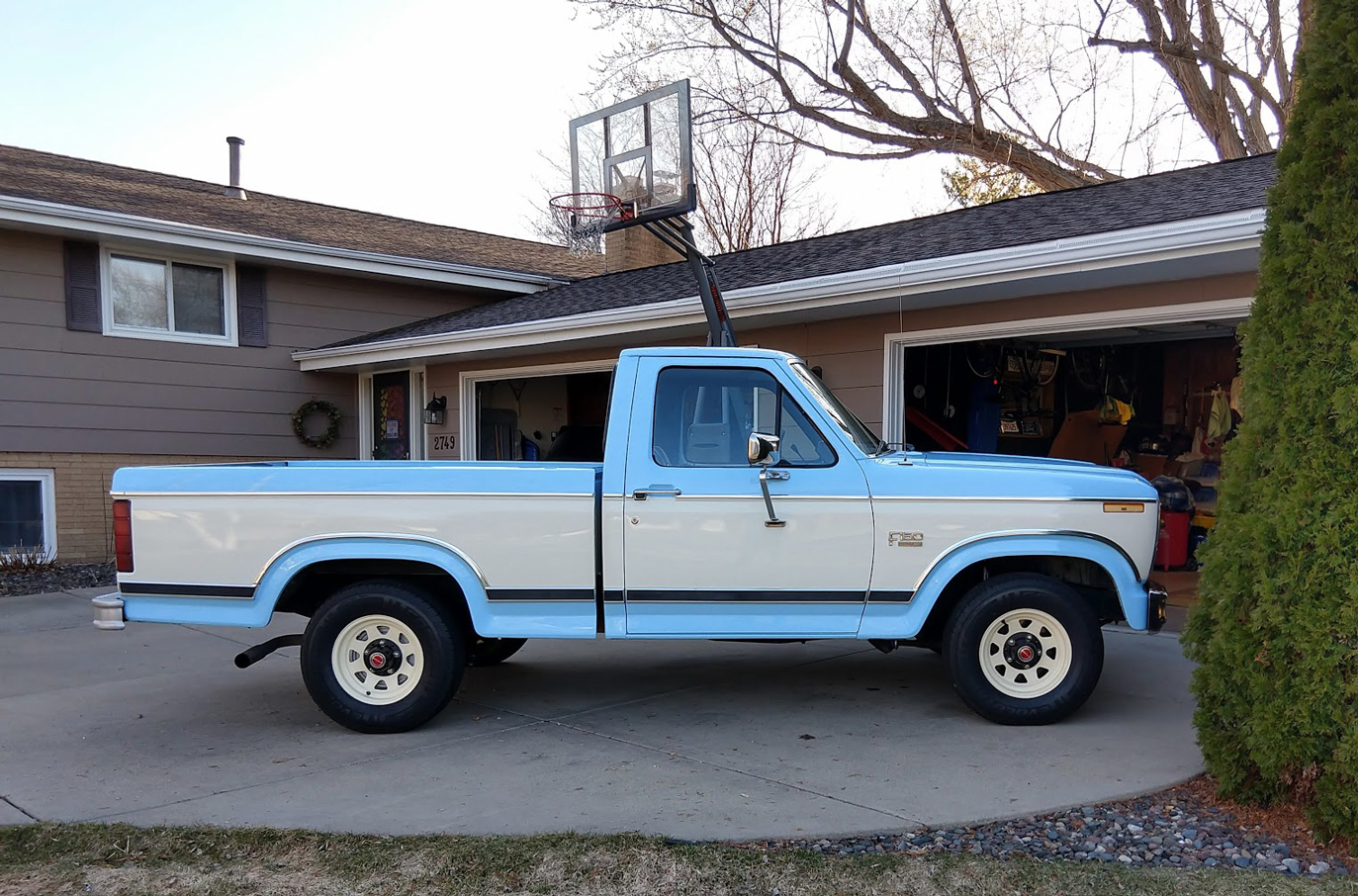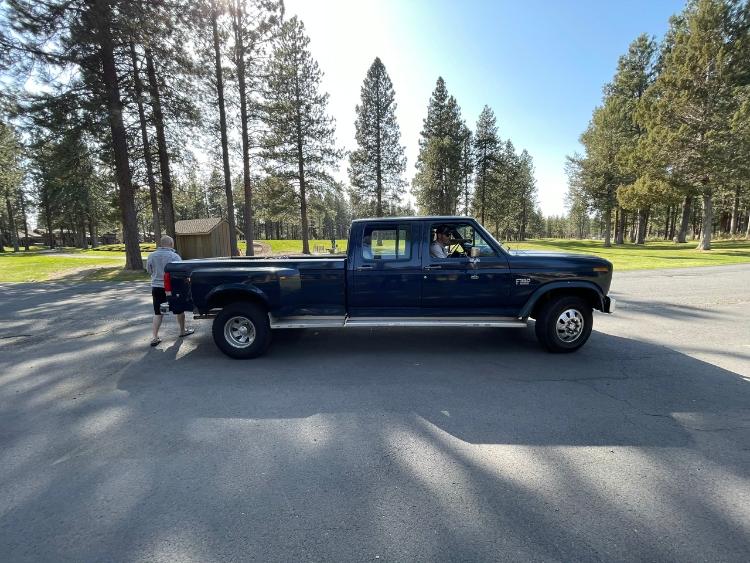Sometimes things go well - happy to share (:
|
My 350 has a factory carb, my Bronco has an Edelbrock.
Maybe that is a factor.
1985.5 F-150 XL Explorer standard cab 5.0 EFI AOD 4x4
Daily Driver. We call her Eunice the Ute. 1982 Bronco XLT Lariat 351W AOD 4x4 Code name Esperanza, or Espy to her friends. Please see my Project thread for the blow by blow. 1984 F-350 XL Centurion crew cab 460 T19 4x4 "Eylza Dual-little" |
|
In reply to this post by LARIAT 85
May as well jump in since I've recently worked a lot on choke and idle stuff. 81 302 with the heat tubes to choke AND the electric assist wire, per Lariat's recommendations and similar to his header setup with the Dorman heat tube kit and two tubes hooked up.
If I pump it once to set choke and start, it will start and run 3 seconds or so, then sputter out - like it runs out of gas. If I try to add gas, it floods? and quits. If I pump it twice, it will start and might catch or might not. If I pump it 3 times, then start, it runs fine everytime. I drive it at least once a week, no matter the temps so long as it's close to freezing or above. Same procedure no matter the temp and no matter how long since last driven if it's the first start of day. Once it catches, it idles about 1200 cold til I start moving. Then at stop sign at end of street (1/4 mile), it may be idling 1600 or higher - I need to check that - not sure what part of linkage to adjust really. At next stop sign 3/4 mile more away, I usually have to pop the throttle to lower the idle down a notch. After that, it usually drops to 1000-1200 til it warms enough to drop to 600 on the main idle circuit. With all that said, by the time I get to Bojangles for a biscuit on Saturday mornings, 4 miles away (6- 10 minutes from home?), it is on hot idle by the time I get to window. It may be at 1200 when I pull in drive thru line, but will get warm enough to drop while in line. I saw that video about pumping while starting and if your choke is working, it opens and closes choke while starting which isn't necessarily good for the starting procedure. Mine may not be that "perfect" one pedal mash start, but it is consistent on the 3 pump start.
Randy
Mt. Airy, NC 81 F-150 STYLESIDE regular cab 2wd. 302 Auto Zone crate. 5 spd M5od-R2 |
Re: Sometimes things go well - happy to share (:
|
Administrator
|
There's "pumping" and there's "flooring". Most carbs have a mechanism to force the choke open when you floor the throttle, and that's used for starting if you suspect the engine is flooded.
So yes, "flooring" the throttle while starting does change the choke. But just "pumping" it w/o going to the floor shouldn't.
Gary, AKA "Gary fellow": Profile
Dad's: '81 F150 Ranger XLT 4x4: Down for restomod: Full-roller "stroked 351M" w/Trick Flow heads & intake, EEC-V SEFI/E4OD/3.50 gears w/Kevlar clutches
|
|
Administrator
|
In reply to this post by LARIAT 85
My truck is carbed with an Edelbroch 1406, auto choke. My truck fires up immediately with one depression of the accelerator pedal for first start when fired up daily. After that initial start, I merely need to turn the key for a prompt start. If it sits for awhile, a week or more, my truck is very much like yours. Frankly, I'm like you in wondering how a carbed vehicle can sit for so long and have an immediate start.
John
"Blackie" - 1986 F150 4x4 - Mildly warmed over 351W HO - Original owner |
|
I have owned a number of carbureted vehicles and currently own 2. With well maintained ignition, carb tuning, and proper fuel and storage methods I have never had a starting issue on my vehicles. 1 full throttle pump sets the choke. There is no need to keep pumping the accelerator unless you are trying to flood the carburetor - you don't want that. Assuming the bowls are dry from sitting/evaporation, turning the ignition pumps fuel into the carb until it starts and then it has the fuel it needs to keep idling if everything is tuned correctly. I do the same procedure on my '66 Mustang, but that has manual choke. I set that by flooring the accelerator and then pulling the choke lever just after before releasing the throttle to set the high idle cam on the carb.
If you keep pumping the accelerator, in addition to flooding the carb you are likely going to disengage the fast idle cam, thus making it more difficult to keep the truck running/idling correctly from a cold start.
'83 F150 XL Shortbox California
302 (EEC-III), AOD, 3.55 - stock original drivetrain |
|
No to hijack the thread, but speaking of carburetor tuning and performance, do we have any folks here who live in the mountains? I know it's an age-old discussion topic about tuning for high altitudes and I think I have the gist of what's involved. What I can't figure out is, do any of you actually drive in the Rockies? And how does a bullnose-era engine perform with a minimally-acceptably-tuned carb going up and down? My issue is I live at 5500' but take trips to 11000' (sometimes more). So what do you do? Tune for 8500 and split the baby? Tune for 5500 and accept some performance loss?
--
1981 F-250 Custom. 6.6L V8, 4 barrel Holley carb, ARA aftermarket A/C. |
Re: Sometimes things go well - happy to share (:
|
Administrator
|
I don't live in the Rockies, but I took Big Blue there last September. I have him tuned for here, which is 700', but took him to 13,000'. He didn't idle very well, but ran ok. However, I'm sure he'll run better with this EFI on him.

Gary, AKA "Gary fellow": Profile
Dad's: '81 F150 Ranger XLT 4x4: Down for restomod: Full-roller "stroked 351M" w/Trick Flow heads & intake, EEC-V SEFI/E4OD/3.50 gears w/Kevlar clutches
|
|
In reply to this post by 66gtk
Lucille is my one and only carbureted vehicle. My entire ignition system is OEM Motorcraft. I am running an OEM Autolite carburetor that is tuned well enough to give me 20-1/2" of vacuum at curb idle (750 RPM). In gear, my truck will idle smoothly at 500 RPM, so I don't think I have a problem there.
I agree, and I never do those things. Daily driven or every other day: 1 single depression of the accelerator to set the choke on a cold start. Fires up faster than my fuel injected vehicles. Warm start: just turn the key.
Sure, but that requires you to crank the engine over for a little while (more than 3-5 seconds for sure) to get the [mechanical] fuel pump to pump enough gas from the gas tank and into the carburetor to fill up the fuel bowl enough to keep the engine running. Right? Unless you running an electric fuel pump? Okay, but you said that your truck sat dormant for FOUR months and started up within 3-5 seconds with only a single depression of the accelerator. So your fuel bowl must not have been dry. But how can that be? Did you leave out something, or did I misunderstand you?
Lucille: 1985 Ford F150 XLT Lariat
*Colors: Dark Canyon Red exterior, Canyon Red interior *Engine: 5.0, CompCams 31-230-3, "Thumper" E7 heads, Edelbrock Performer intake, Autolite 4100 carburetor, DuraSpark II ignition, Thorley Tri-Y headers, Flowmaster dual exhaust, H-pipe. *Drivetrain: AOD transmission, 3.55 gears, 2wd. |
|
I assume due to length of time in hibernation that the fuel bowl was dry. Just like it is in my Mustang after months of not using it. I'm sticking to my story with 5 seconds of cranking and it fired right up needing only one initial accelerator pump to the floor to set choke and fast idle cam. Same as last spring after winter storage. (: I have done a tune up recently with all new spark plugs, wires, rotor, cap, etc. 10w30 dino oil. About 50 degrees F.
'83 F150 XL Shortbox California
302 (EEC-III), AOD, 3.55 - stock original drivetrain |
|
I also will report that I drove it yesterday after it was sitting for over a week. Same thing - One pump and it started in about 3 seconds. 35 degrees outside. My truck is kept in a garage.
'83 F150 XL Shortbox California
302 (EEC-III), AOD, 3.55 - stock original drivetrain |
|
This post was updated on .
In reply to this post by 66gtk
What year Mustang do you have? I find it very interesting that your mechanical fuel pump could fill up a dry fuel bowl (from 4 months of sitting) within 5 seconds and allow your engine to turn over and continue running with only one single pump of the accelerator pedal. I am curious: did you depress the accelerator first and then crank the engine? Or did you crank the engine first and then depress the accelerator?
Lucille: 1985 Ford F150 XLT Lariat
*Colors: Dark Canyon Red exterior, Canyon Red interior *Engine: 5.0, CompCams 31-230-3, "Thumper" E7 heads, Edelbrock Performer intake, Autolite 4100 carburetor, DuraSpark II ignition, Thorley Tri-Y headers, Flowmaster dual exhaust, H-pipe. *Drivetrain: AOD transmission, 3.55 gears, 2wd. |
|
I have a 1966 Mustang.
Always press the accelerator FIRST (all the way to the floor) prior to turning over to set the choke and the fast idle cam.
'83 F150 XL Shortbox California
302 (EEC-III), AOD, 3.55 - stock original drivetrain |
|
This post was updated on .
Of course, but the engine won't start unless there is enough fuel in the fuel bowl to actually prime the carburetor. How do the carburetors in your truck and Mustang manage to retain enough fuel in the fuel bowls to get the engine to start within 3 - 5 seconds after sitting for FOUR months? That is what I would like to know. I have an Autolite 4100 from a 1965 Ford Mustang in Lucille, and there is no way mine would start as fast as yours after sitting that long.
Lucille: 1985 Ford F150 XLT Lariat
*Colors: Dark Canyon Red exterior, Canyon Red interior *Engine: 5.0, CompCams 31-230-3, "Thumper" E7 heads, Edelbrock Performer intake, Autolite 4100 carburetor, DuraSpark II ignition, Thorley Tri-Y headers, Flowmaster dual exhaust, H-pipe. *Drivetrain: AOD transmission, 3.55 gears, 2wd. |
|
My truck has been sitting for a week, and with the weather in the forecast it might be another before I start it again? I'll try and remember to record the cold start and post it up. Granted it's not months old, but....
My Mustang has been sitting since early October. I can record that first start (sometime next month), but it usually takes 2 rounds of cranking on the first start of the year with that one as I don't want to overheat the starter (: That one is running a Holley 1850 with a manual choke. Still has dual point distributor - original style old school ignition.
'83 F150 XL Shortbox California
302 (EEC-III), AOD, 3.55 - stock original drivetrain |
|
I started it up last evening for the first time in weeks. I recorded it for your viewing.
https://youtu.be/s7GYsow2oQg
'83 F150 XL Shortbox California
302 (EEC-III), AOD, 3.55 - stock original drivetrain |
Re: Sometimes things go well - happy to share (:
|
Administrator
|
Well done! That shows just how well a properly-adjusted system starts.

Gary, AKA "Gary fellow": Profile
Dad's: '81 F150 Ranger XLT 4x4: Down for restomod: Full-roller "stroked 351M" w/Trick Flow heads & intake, EEC-V SEFI/E4OD/3.50 gears w/Kevlar clutches
|
|
In reply to this post by 66gtk
Thanks for following through and making a video demonstration. That is a very nice Ford!  I usually drive Lucille once a week, and she starts up *exactly* like that when she sits that long. But after about 2 - 3 weeks, I have to repeat that procedure 2 - 3 times before the engine will start. It 's not a problem at all, but I wonder why mine takes that extra cranking time while yours doesn't? P.S. I really like your tires. I was thinking about getting a set of those for Lucille. That is actually the exact same style these trucks left the factory with! And Wal-Mart has them (even though I hate Wal-Mart) for only $90 a piece. How do you like them?
Lucille: 1985 Ford F150 XLT Lariat
*Colors: Dark Canyon Red exterior, Canyon Red interior *Engine: 5.0, CompCams 31-230-3, "Thumper" E7 heads, Edelbrock Performer intake, Autolite 4100 carburetor, DuraSpark II ignition, Thorley Tri-Y headers, Flowmaster dual exhaust, H-pipe. *Drivetrain: AOD transmission, 3.55 gears, 2wd. |
|
Thanks guys. I feel blessed this truck starts well and runs fairly good now. I purchased it as a non-op, so saving all the original plumbing and making it work feels like an accomplishment.
I put those tires on for one reason - they look exactly like the ones in the original brochure! They are also affordable, and they look great with my white wheels. I had blackwalls on for 1 year and decided to switch it up when I found these wheels. They look great and do the job for a street truck that can't go very fast at all (:   BEFORE with different wheels and tires 
'83 F150 XL Shortbox California
302 (EEC-III), AOD, 3.55 - stock original drivetrain |
|
The white letters definitely look better! I can't believe these tires are still available. The design dates all the way back to the 1980s!
What size tires are you running? Have you ever considered swapping out your amber front turn signal lenses for earlier white ones? The white lens was available for the 1980 model year, but I think it would look great (while still looking stock) with your white wheels and the two-tone blue and white on your truck.
Lucille: 1985 Ford F150 XLT Lariat
*Colors: Dark Canyon Red exterior, Canyon Red interior *Engine: 5.0, CompCams 31-230-3, "Thumper" E7 heads, Edelbrock Performer intake, Autolite 4100 carburetor, DuraSpark II ignition, Thorley Tri-Y headers, Flowmaster dual exhaust, H-pipe. *Drivetrain: AOD transmission, 3.55 gears, 2wd. |
|
That wheel/tire combo is such a good look!
I didn’t realize the clear side marker lenses were a stock item at one time. I think those would look real nice on my dually. 
1985.5 F-150 XL Explorer standard cab 5.0 EFI AOD 4x4
Daily Driver. We call her Eunice the Ute. 1982 Bronco XLT Lariat 351W AOD 4x4 Code name Esperanza, or Espy to her friends. Please see my Project thread for the blow by blow. 1984 F-350 XL Centurion crew cab 460 T19 4x4 "Eylza Dual-little" |
| Edit this page |

